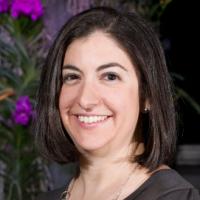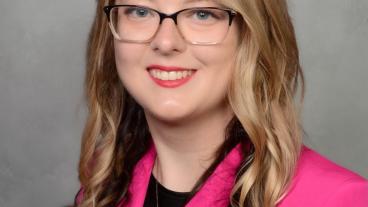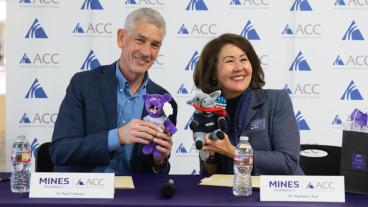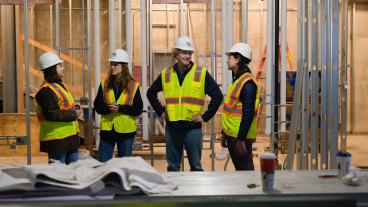Building on an idea: Battery Workforce Challenge team creates electric vehicle for multi-year competition
Mines team spends second year of three-year competition making community connections, forging ahead
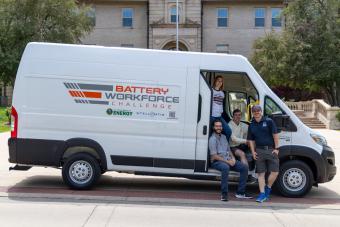
Viviana Nelson, Jarev Peña and Trevor Heise, three of the members of the Mines/ACC Battery Workforce Challenge team, along with Adam Duran, teaching assistant professor of mechanical engineering and one of the team's faculty advisors, stop on the Mines campus with the 2024 Ram ProMaster EV van the team electrified.
While many college students are filling their summer breaks with internships and travel opportunities, a group of students at Colorado School of Mines is spending theirs in the basement of Brown Hall.
“We call it the bay,” said Viviana Nelson, a senior in mechanical engineering. “We are there all the time, there’s a fridge. It’s basically where we live.”
The bay is where Nelson and fellow members of Mines’ Battery Workforce Challenge team are working on electrifying a 2024 Ram ProMaster EV van.
Over the three-year collegiate competition – sponsored by global automaker Stellantis and the U.S. Department of Energy – the team has designed, built and will now integrate an advanced, custom electric vehicle battery pack into the van.
The Mines students paired up with automotive technology students from Arapahoe Community College to compete in the challenge, and they’ve made some impressive gains so far. In 2024, they were named Year 1 champions and earlier this summer, placed fourth out of 12 teams from the U.S. and Canada for Year 2.
“It’s been fulfilling to see how the Mines/ACC Battery Workforce Challenge team has grown in its second year,” said Polina Brodsky, teaching assistant professor of mechanical engineering and one of the team’s faculty advisors. “The students have not only deepened their technical skills as they moved from the design phase into prototyping this year, but also grown significantly in confidence, collaboration and leadership. As an advisor, it’s rewarding to watch them tackle such a complex, real-world challenge and develop the kind of hands-on experience that will serve them well in the energy and automotive industries.”
The second year wasn’t without its challenges. As students on the team graduated and moved on from Mines, leadership changed along with the project’s goals. While Year 1 was all about design and planning, Year 2 focused on the actual manufacturing, build and testing.
But Nelson said one of the biggest challenges to overcome was the feeling of being an underdog. Some of the other teams that Mines and ACC are competing against have larger student bodies, more financial support and resources, and more experience in automotive competitions.
“Relative to some of the other teams that have had a lot more years competing in these events or automotive-based sponsorships, we are still performing very well and are very strong, comparatively,” Nelson said. “We’ve built a lot of new relationships and strengthening our automotive program and have been receiving a lot of support from both Mines and ACC. Mines has put a lot of energy and effort into the team and that’s definitely been reflected in our performance.”
Adam Duran, teaching assistant professor of mechanical engineering and co-advisor of the team with Brodsky, said the university’s backing of the team was a key part of their success.
“University leadership has been exceptionally supportive of the Battery Workforce Challenge team, recognizing its alignment with our mission to deliver hands-on, industry-relevant engineering education,” he said. “The team is grateful for the institutional backing that has enabled our students to contribute meaningfully to the future of mobility while simultaneously gaining critical experience in multidisciplinary collaboration, innovation and leadership.”
Community Involvement
Along with the work on the actual van, which arrived on campus in spring 2025, the team has also extended their reach beyond Mines, becoming involved with several local community groups.
Jarev Peña, a mechanical engineering major who works on project management for the team, managed one event with TRIO Talent Search, a program run by Colorado State University for middle and high school students aspiring to be the first in their family with a college degree. Peña, who took part in a similar program when he was in in high school, led a tour of the Mines campus, a workshop about mechanical energy and a panel discussion with members of the Battery Workforce team.
“The event gives them something very memorable and a different perspective of what college is all about,” Peña said. “They got to see the hands-on options and activities you get to do at an engineering university.”
The team also was involved in Dia de Ciencias, or Day of Science, an event run by Mines’ chapter of Society of Hispanic Professional Engineers. SHPE invited K-12 students to campus for a day full of activities introducing them to what Mines is all about, and the Battery Workforce team set up a demo for the students. Dia de Ciencias was one of several local events the team participated in during Year 2, as well as the Rocky Mountain Automotive Teacher Society conference, Girls & Science at the Denver Museum of Nature and Science and a demo and activity with Teaching the Autism Community Trades.
“We’d love to continue doing youth outreach with the connections we already have and making some new ones, too,” Peña said.
What’s Next?
Heading into the third and final year of the competition, the team is looking ahead to the finish line.
The final goal: Get a battery pack functioning in the van. That’s the overall mission for the team, but Nelson said they’d also be focusing on team building and professional development.
Some former team members who are now alumni have also been coming back to advise the group. Trevor Heise, who graduated with his bachelor’s degree in May 2025, is one of them.
“I think an important thing for me to do is being a sort of mentor for new leadership,” Heise said. “I won’t be moving too far away, so if people have questions, I’m always happy to pop down once in a while and answer them. No matter who’s stepping up into leadership, I can give them some words of wisdom, some guidance on where they want to lead the team, so the vision actually comes to life.”
Nelson said many of the Year One alumni have also made guest appearances in Year Two. Colten Kristie, a Mines alum who was on the project management team and now works for General Motors in St. Louis, has especially been a great resource, she said, lending his expertise and perspective as a professional in the automotive industry.
“It can be really tough to transfer all the knowledge from year to year, but the alumni have been happy to join a call or respond to our questions,” Nelson said. “They all have fond memories of being on the team and I think we’re going to have a lot more alumni stay involved from Year Two into Year Three.”
As the team looks forward to the final year of the challenge, Duran said the experience the students have acquired will boost them as they become professional engineers.
“In the second year, they have matured into a high-functioning engineering team, operating with a level of professionalism and efficiency that mirrors those in industry,” Duran said. “As a faculty adviser, it is rewarding to observe the team’s growth and to support students as they shift from design into execution. The technical, leadership and systems-thinking skills they are developing will be critical to their future careers.”

